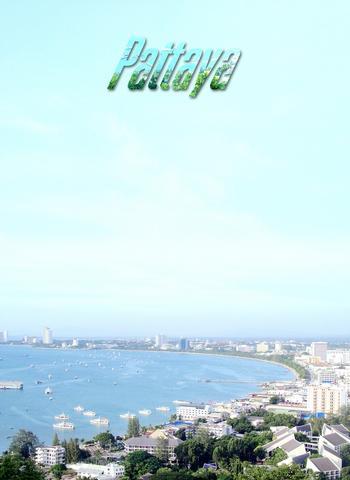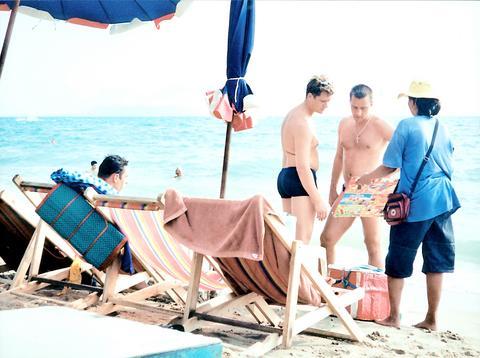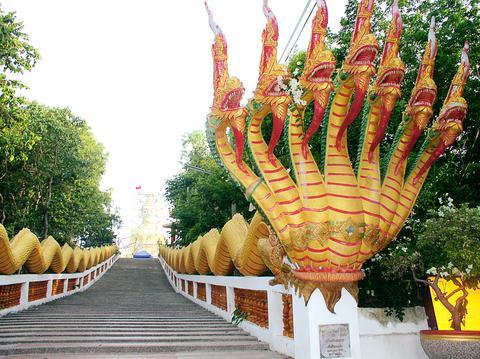Pot-bellied German pederasts mincing around in flowery shirts, Dutch dropouts, Austrian dykes with piercings, French ex-colonial heavies, Russian teenage girls squirming as they listen to their ghetto-blasters -- it's hard to forget Michel Houellebecq's portrait of Thailand's premier east coast resort at the end of his sensational 2001 novel Platform.
And this has constituted Pattaya's reputation ever since it was first developed as an R&R resort for American troops during the Vietnam War. The whole of the coarse West's exploitation and despoliation of the exquisite East seemed to be summed up in that one word -- Pattaya.

But what's it like today? What's changed? There's been much publicity promoting a reformed, cleaned-up Pattaya. Has the grisly old leopard, redolent of musk and stale beer mats, really managed to change its suppurating spots?

PHOTO: BRADLEY WINTERTON
It's certainly the case that the vast majority of Taiwan's visitors to Thailand go there -- girlfriends, wives and young children included. Three nights in Bangkok and two in Pattaya is the standard tour-package offered at any Taipei travel agent.
So, do these people see the place as Houellebecq saw it? Or could it be the case that, instead, they see something completely different?

PHOTO COURTESY OF PATAYA MAIL, SUCHADA TUPCHAI
The truth of the matter, as with so many matters, lies somewhere in between. Pattaya's nightlife, which was once dirty, seedy and disreputable, is nowadays clean, tidy and disreputable. Bars still flaunt girls and boys with numbers round their waists dancing lazily until someone from the audience picks them out and pays to take them away for an hour or two (though some battered old no-hopers, it should be said, manage to find partners for what's left of their lives in this manner).
But for the rest, Pattaya today is remarkably comfortable, healthy and even salubrious. Its best hotels are outstanding, its restaurants serve quality food from the most celebrated European cuisines, its beaches are safe and congenial, and the quality of the sea water, not so long ago dubious, is now somewhere between good and excellent.
On a hot Thai morning you can walk down the pedestrianized Golden Mile (officially known as the Walking Street), take an espresso and croissant while overlooking the bay where the jet-ski operators are getting ready for another busy day, and all there is to offend the most Protestant sensibility is a waiter sponging down the bar-stools where a few hours previously Thai and other girls were, as Houellebecq would have it, squirming to the sound-system.
You can then take an open-sided mini-bus to Jomtien Beach ten minutes away, overlooked by condominiums housing the town's large number of expatriate retirees, and enjoy a day in a deckchair under a beach umbrella with no one to bother you. There may well be some strange spectacles promenading in front of you along the sand, but why not? It's free theater, after all, and surely the girls and boys who've labored away so hard the night before, cruelly exploited as they undoubtedly are, also deserve their afternoon in the sun.
Pattaya's best hotels are marvelous indeed. The Royal Cliff (tel: 66-38-250420), perched high on its promontory, with its 10 restaurants and five swimming-pools, is internationally famous. The Montien Hotel (tel: 66-38-428155) is also a high-quality hostelry.
But the hotel I would recommend is the Siam Bayshore Resort (tel: 66-38-428-678; siambayshore@siamhotels.com), on account of its competitive prices and unparallelled location. It stands at one end of the Golden Mile, and so is ideally situated for this formerly steamy strip -- nowadays safe, clean, and yet still vibrant after dark.
The hotel offers rooms of five-star quality at four or even three-star prices and is notably eager to please. It has Chinese, Italian and other restaurants and a swimming pool overlooking Pattaya Bay. You only have to step out of the front door to find transport to anywhere in the Pattaya region or further along the east coast.
The character of the so-called Golden Mile needs to be explained. There are huge, open-fronted bars offering an infinity of beers and erotic provender, none of it free-of-charge, needless to say. There are also banks with reliable cash-machines, smaller restaurants and nightclubs, the occasional neighborhood store and studios where artists paint your portrait to positively Renaissance standards (and, if you like, with an actual Renaissance background).
Walking back to the Bayshore one quiet Monday night, I was electrified when a live four-piece band of broadly-smiling Thais suddenly exploded into the Gloria Gaynor classic I Will Survive. Dancing immediately broke out, spilling onto the street -- Russians, Taiwanese, Chinese and even one or two Thais, all waving frothing beer mugs and singing along. Watching aghast, but with the beginnings of a smile, were a group of what looked like, and probably were, Gulf State migrant workers, dressed as if for a trip into the desert with their falcons, or as extras for Lawrence of Arabia. If this is cultural exchange, Pattaya in the age of globalization, I thought, then you have no alternative but to admire it.
As for restaurants, Pan Pan (tel: 251874) at Jomtien offers top-class Italian cuisine, the Mata Hari (tel: 420939) the best of Belgian and Thai food, and Bruno's (tel: 364600) classic central European cuisine.
For the rest, there are elephants, para-sailing operators, unlimited motorcycles for hire, Buddhist temples and a brand-new pier (as well as a far more atmospheric old wooden one, these days on its last legs).
A pleasant surprise is to find a good home-grown Thai wine. It's called Kao Kai Valley, and comes in both red and white. It's made by the same company that produces the celebrated Singha Beer, and really is exceptionally palatable.
Pattaya is these days all things to all men -- women are perhaps less likely to be amused, though the best of them will down a couple of vodkas and join in the fun. It still relies for its attraction on sailing close to the wind, as it always has. But today it's the classic old whore who's made her money and become half-respectable, beaming indulgently at the raffish goings-on among the younger crowd.
Its genial hoteliers will smile and tell you everything's open and above-board, and so it is, so long as you don't venture too far down some of the darker alleys, or walk alone displaying a gold necklace where a motorcyclist could waylay you unnoticed.
At its best Pattaya today is both lively and comfortable -- an enviable combination. Its superb hotels and restaurants, plus agreeable beaches, will be enough for most people. If you want to take in the nightlife as well, then there's a voyeuristic pleasure in store, and possibly more. But sex-for-money no longer defines Pattaya -- it's nowadays bigger and more varied than that. Nevertheless, it's precisely because of its very riskiness that Pattaya, for all its scandals and former woes, is still somewhere with a unique allure.
You'll meet the widest possible range of humanity there and, if you're going to Thailand anyway, it's not to be missed.
Bradley Winterton is the author of `The Insider's Guide to Thailand' (Kummerly and Frey, Switzerland), published in the US by the Globe Pequod Press as `The Traveler's Thailand Companion.'

May 11 to May 18 The original Taichung Railway Station was long thought to have been completely razed. Opening on May 15, 1905, the one-story wooden structure soon outgrew its purpose and was replaced in 1917 by a grandiose, Western-style station. During construction on the third-generation station in 2017, workers discovered the service pit for the original station’s locomotive depot. A year later, a small wooden building on site was determined by historians to be the first stationmaster’s office, built around 1908. With these findings, the Taichung Railway Station Cultural Park now boasts that it has

The latest Formosa poll released at the end of last month shows confidence in President William Lai (賴清德) plunged 8.1 percent, while satisfaction with the Lai administration fared worse with a drop of 8.5 percent. Those lacking confidence in Lai jumped by 6 percent and dissatisfaction in his administration spiked up 6.7 percent. Confidence in Lai is still strong at 48.6 percent, compared to 43 percent lacking confidence — but this is his worst result overall since he took office. For the first time, dissatisfaction with his administration surpassed satisfaction, 47.3 to 47.1 percent. Though statistically a tie, for most

Wooden houses wedged between concrete, crumbling brick facades with roofs gaping to the sky, and tiled art deco buildings down narrow alleyways: Taichung Central District’s (中區) aging architecture reveals both the allure and reality of the old downtown. From Indigenous settlement to capital under Qing Dynasty rule through to Japanese colonization, Taichung’s Central District holds a long and layered history. The bygone beauty of its streets once earned it the nickname “Little Kyoto.” Since the late eighties, however, the shifting of economic and government centers westward signaled a gradual decline in the area’s evolving fortunes. With the regeneration of the once

In February of this year the Taipei Times reported on the visit of Lienchiang County Commissioner Wang Chung-ming (王忠銘) of the Chinese Nationalist Party (KMT) and a delegation to a lantern festival in Fuzhou’s Mawei District in Fujian Province. “Today, Mawei and Matsu jointly marked the lantern festival,” Wang was quoted as saying, adding that both sides “being of one people,” is a cause for joy. Wang was passing around a common claim of officials of the People’s Republic of China (PRC) and the PRC’s allies and supporters in Taiwan — KMT and the Taiwan People’s Party — and elsewhere: Taiwan and